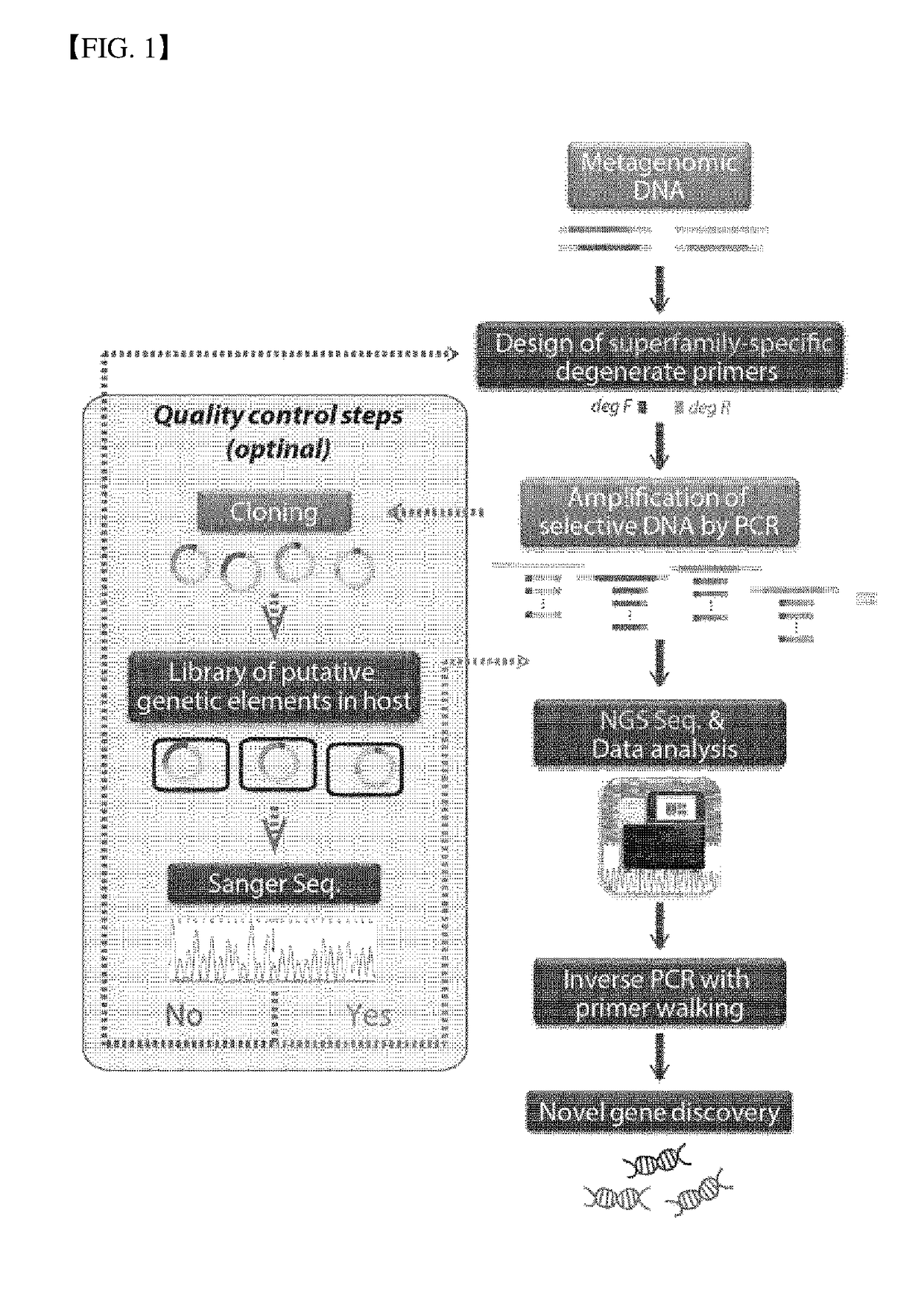Method for Exploring Useful Genetic Resources Through Bulk Metagenome Analysis and Use Thereof
a metagenome and bulk technology, applied in the field of highthroughput screening useful gene products by metagenomics analysis, can solve the problems of difficult to provide conditions similar to the original natural environment in which microorganisms are present, the feasibility of enzymes is so low, and the presence or absence of more than 99% of the microorganisms cannot be easily detected. , to achieve the effect of high speed, quick determination of utility value, and rapid detection of presence or absen
- Summary
- Abstract
- Description
- Claims
- Application Information
AI Technical Summary
Benefits of technology
Problems solved by technology
Method used
Image
Examples
example 2
e Chain Reaction (PCR) and Confirmation of Amplified Gene Fragments
[0136]In order to confirm whether the prepared degenerate primers for screening catalase hydroperoxidase II (KatE) (SEQ ID NO: 1: 5′-CRC TTY GAY CAY GAR MGB ATY CC-3′ and SEQ ID NO: 2: 5′-ATG AAR AAS ACH GGV AWG TTR TTB CC-3′) bind to a target gene, the polymerase chain reaction (PCR) was performed in which the genomic DNA of Escherichia coli MG1655, in which the amino acid sequence of the KatE gene was used for the production of the degenerate primer, was used as a template. The remaining degenerate primers were also subjected to the polymerase chain reaction (PCR) using the genomic DNA of Escherichia coli MG1655 as a template. Exceptionally, in order to confirm the binding of degenerate primers for subtilisin and cellulase detection to the target gene, the polymerase chain reaction (PCR) was performed using genomic DNA of Bacillus subtilis 168 rather than Escherichia coli MG1655, as a template.
[0137]The PCR reactio...
example 3
of Nucleotide Sequences of Amplified Gene
[0140]The PCR product was purified using Qiaquick Gel extraction kit (QIAGEN, Germany) and ligated to a pGEM T-easy vector (Promega, USA) to construct vectors pGEM T-katE, catA, gabT, wegB, araA, phy, aprE, ytoP, eglS, tpiA, and pyrK including genes encoding catalase hydroperoxidase II, catalase hydroperoxidase I, GABA transaminase, UDP-N-acetylglucosamine-2-epimerase, L-arabinose isomerase, phytase, subtilisin, cellulase, triosephosphate isomerase, and pyruvate kinase of Escherichia coli MG1655.
[0141]Further, the recombinant vector was mixed with 100 μl of Escherichia coli DH5 (competent cells) prepared for transformation, and then the transformed Escherichia coli into which the vector was introduced was heat-shocked at 42° C. for 90 seconds, and plated on LB medium including 100 μg / ml ampicillin, thereby screening transformed Escherichia coli. In order to recover plasmid DNA, a plasmid extraction kit (Biofact, Korea) was used to recover the...
example 4
e Chain Reaction (PCR) of the Metagenome and Confirmation of Amplified Gene Fragments
[0142]After confirming the binding ability of the prepared degenerate primers to the target gene, a polymerase chain reaction was carried out for screening the target gene using the metagenome as a template. The PCR reaction solutions used were as follows: final 25 μl solution including 100 ng template (metagenomic DNA of obtained Soil), 12.5 μl EmeraldAmp GT PCR Master Mix, 0.2 μM (final concentration) each forward and reverse degenerate primer, and sterilized distilled water. The PCR reaction was performed by 30 times of a cycle consisting of denaturation at 94° C. for 30 seconds, annealing at X° C. (for example, 54° C. of catalase hydroperoxidase II and catalase hydroperoxidase I; 58° C. of GABA transaminase, UDP-N-acetylglucosamine-2-epimerase, and L-arabinose isomerase; 52° C. of phytase and cellulase 2; 56° C. of subtilisin and pyruvate kinase, 51° C. of triosephosphate isomerase; and 47° C. o...
PUM
| Property | Measurement | Unit |
|---|---|---|
| Temperature | aaaaa | aaaaa |
| Temperature | aaaaa | aaaaa |
| Fraction | aaaaa | aaaaa |
Abstract
Description
Claims
Application Information
 Login to View More
Login to View More - R&D
- Intellectual Property
- Life Sciences
- Materials
- Tech Scout
- Unparalleled Data Quality
- Higher Quality Content
- 60% Fewer Hallucinations
Browse by: Latest US Patents, China's latest patents, Technical Efficacy Thesaurus, Application Domain, Technology Topic, Popular Technical Reports.
© 2025 PatSnap. All rights reserved.Legal|Privacy policy|Modern Slavery Act Transparency Statement|Sitemap|About US| Contact US: help@patsnap.com



